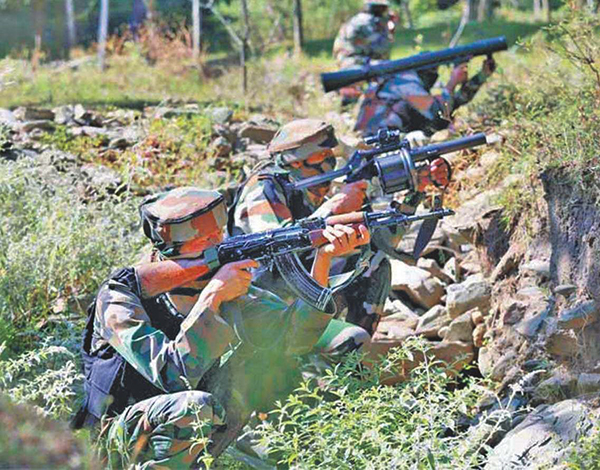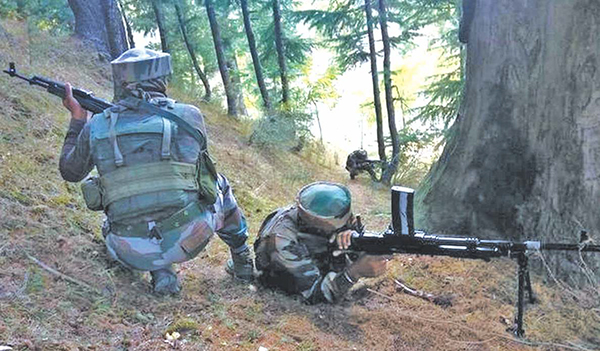There has been an unusual spike in ceasefire violations (CFVs) by the Pakistan army along the Line of Control (LoC) in 2020 to help infiltrators sneak into Jammu & Kashmir (J&K) compared to border violations in the previous years. The Pakistani army carried out more CFVs during January-March 2020 compared to the corresponding periods of the previous two years.
The volatile 778-km long Line of Control (LoC), recorded over 1,547 times until 3 May from January – nearly half of the entire year’s figure in 2019 at 3,168.
The highest number of violations (411) were recorded in March 2020 when Covid-19 cases started peaking globally.
There were 3,479 CFVs and firings across the LoC and the 198-km international border (IB) in J&K in 2019, smashing all annual records since 2003.
The upward trend in CFVs has continued since the government revoked the special status of J&K on 5 August 2019 and then split the state into two union territories. Though there was a general decline in terrorist violence in the hinterland, with the snow in the mountain passes melting, there has also been a spike in infiltration attempts.
In April 2020, as many as 28 terrorists were killed in J&K – the highest since August 2019. 64 terrorists were killed in Kashmir and along the LoC in 2020 so far. In 2019, 152 terrorists were killed in J&K as against 215 in 2018, official figures stated.
Islamabad also blamed the Indian Army of 708 ceasefire violations in 2020, that it said killed two civilians and injured another 42.
Recruitment Up
The bigger cause of worry was that at least 35 local youths had joined terror groups in the first four months of this year, according to official figures of the armed forces. The local recruitment in 2019 was 119 – much less than 219 in 2018.
The Indian security forces have gone on the offensive, keeping the approaching summer in mind when infiltration attempts increase along the LoC and terrorists in the Valley become very active.
Casualties
Since 21 March, at least 33 militants and two of their associates have been killed in 15 gunfights across the Valley. Most of these encounters took place in four districts of south Kashmir – Pulwama, Shopian, Kulgam and Anantnag, which are considered the hotbed of militancy.
Twenty security personnel lost their lives in this period. Eighteen were killed in gunfights and in attacks by militants, and two army men died on the LoC in CFVs by Pakistan.
Terror Factories in Pakistan
Terror factories in Pakistan are continuing training modules and launch pads along the border from where the final push is made to cross over are also active. The encounter in the Keran sector, on 5 April, in which five special forces soldiers died while taking down a group of infiltrating terrorists-also showed a clear Pakistan hand, with recoveries of food packets and other supplies that had evident markings.
Army chief, Gen MM Naravane also accused Pakistan, on 17 April, of backing terrorism in the region at a time when the world was united to fight the Covid-19 pandemic. “While the whole world is focused towards fighting Covid-19, Pakistan-instigated terrorists have been targeting innocent civilians in the hinterland; just three days back they targeted a retired Kashmiri soldier. Therefore, we cannot let our guard down,” Naravane said.
Intelligence Assessment
Intelligence agencies had earlier pointed to terror launch pads that had been activated in Pakistan-occupied Kashmir’s (POK) Dudhnial, Sharda and Athmuqam across the Keran sector on this side of the Line of Control.
The encounters which happened during March to April point towards Pakistan-backed terrorist groups focusing on north Kashmir. It was a renewed attempt by Pakistan to give Kashmir terrorism a local face. According to an assessment presented to national security planners in late April, the ISI had messaged the 100-odd foreign terrorists to lie low and let the local terrorists front the battle with security forces.
The assessment was that foreign terrorists would be consolidating logistics, expanding the overground workers facilitation network and concentrating on recruitment of Kashmiri youth. Foreign terrorists had also stepped up efforts to radicalise the youth in the Doda-Kishtwar-Ramban range to prepare them for recruitment.
The intelligence brief had also predicted a spike in terror activities and attacks from April, after the starting of Ramzan.
NSA’s Review
National Security Adviser Ajit Doval carried out a complete operational review of the security situation in Jammu & Kashmir on 9 May. The review meeting was attended by Army Chief General Manoj Mukund Naravane, Intelligence Bureau director Arvinda Kumar, Research and Analysis Wing chief Samant Kumar Goel, Border Security Force director general SS Deswal, Central Reserve Police Force chief AK Maheshwari. Northern Army Commander Lt Gen YK Joshi, and general officer commanding of the army’s Srinagar-headquartered 15 corps Lt Gen BS Raju and the Nagrota-based 16 corps commander Lt Gen Harsha Gupta and Jammu and Kashmir police chief Dilbag Singh had also attended the high-level review at New Delhi.
The meeting noted Pakistan government’s renewed push from terror launch pads, the rise in infiltration and how Pakistan was funding newly-created outfits such as The Resistance Front or the J&K Pir Panjal Peace Forum to claim that terrorism in the Kashmir valley was indigenous and not sponsored by Pakistan.
Placing the Pakistan Air Force on high alert was assessed as an effort to further Imran Khan’s narrative that asks the international community to intervene lest there is a confrontation between the two nuclear-armed neighbours.
Comments
The security grid has increased surveillance in the four districts of south Kashmir, while also keeping a close watch on the LoC. The months of April and May saw a pattern of encounters going up every year, when the snow starts melting on the upper reaches of the Himalayas and militants start infiltrating from POK into Kashmir.
With modern surveillance gadgets, security forces are registering big successes in tracking and zeroing in on militants. Once a militant is caught on radar, he is tracked through electronic surveillance, and the success is remarkable. Also, human intelligence inputs help the forces to coordinate operations in the better way. Intelligence gathering has also seen a marked improvement.
A section of security officials and experts believes CFVs by Pakistan are a desperate attempt to foment unrest in India.
In the security grid, many consider these CFVs an attempt to give a cover fire to help militants crossing over to India.
Pakistan’s strategy of pushing terrorists across the border continues unabated. It’s likely that Pakistan is actually trying to take advantage of the Covid-19 outbreak and hit India with terror strikes when the latter is trying to control the epidemic. Plus, the nullification of special status of J&K by New Delhi last year did not lead to the kind of unrest that Islamabad had expected.



















